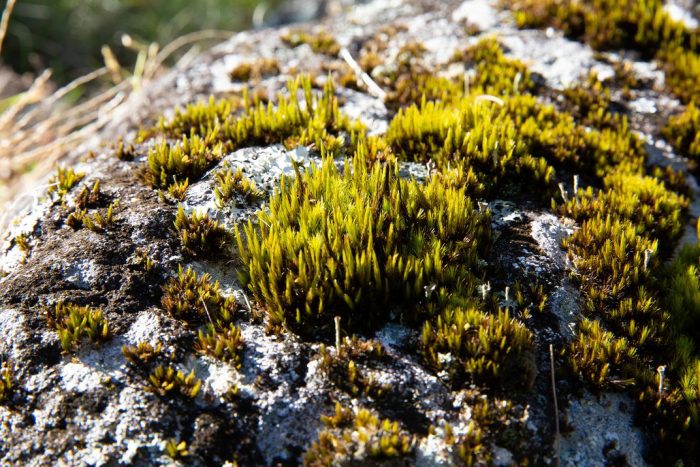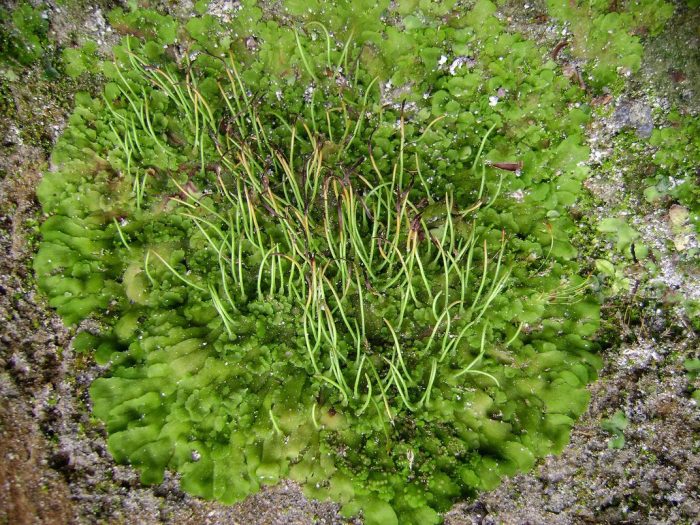Smithsonian Voices: Tiny plants in a big, changing world
A rolling stone may gather no moss, but these busy descendants of the first plants grow pretty much anywhere else.
The world of mosses, liverworts and hornworts, collectively known as bryophytes, form a beautiful miniature forest; nonetheless they are often overlooked, due to their small size and lack of colorful flowers. But it is precisely those characteristics that make bryophytes incredibly interesting from an evolutionary standpoint.

“Bryophytes have a fascinating and complex biology,” STRI research associate and former Tupper post-doctoral fellow, Juan Carlos Villarreal, points out. “The evolutionary adaptations of these plants to succeed despite their size is really interesting.”
Bryophytes also play a very important role in the environment: they colonize sterile soils, absorb nutrients and water and release them slowly back into the ecosystem, contributing to the formation of soil for new plants to grow on.
Still, there is much to learn about bryophytes, especially in the tropics where there are less abundant and therefore less studied. There is a growing interest in boosting the study of bryophytes in the tropics, to discover more about their evolution, and their role in the biodiversity of the region.
“Each species has its role in nature,” Villareal adds, “and each new species demonstrates that biodiversity needs attention, we need to know how many species we have to know their ecological function.”

What are bryophytes?
Bryophytes is the informal group name for mosses, liverworts and hornworts. They are non-vascular plants, which means they have no roots or vascular tissue, but instead absorb water and nutrients from the air through their surface (e.g., their leaves). Most of them only grow a few centimeters in height, and since they don’t need roots, they can grow in places that other plants cannot, like on the surface of rocks, walls, pavement, etc. Bryophytes thrive in damp, shady environments, but they can also be found in diverse and even extreme habitats, from deserts to arctic areas. Globally there are around 11,000 moss species, 7,000 liverworts and 220 hornworts.
As they are not flowering plants, bryophytes reproduce by spores instead of seeds.
“They can produce thousands or millions of spores, and they disperse them using the wind as their vector,” Villarreal says. “The dispersion capabilities of some species are incredible: their spores even reach other countries and continents.”

They are also long thought to be the closest living relatives to the very first terrestrial plants, with ancestors dating as far as half a billion years. However, recent studies tend to present a different hypothesis, although not undermining their evolutionary potential.
“Bryophytes therefore can reveal information about how the first plants adapted in their conquest of the terrestrial environment”, says Noris Salazar Allen, a staff scientist at STRI and specialist in plant systematics.
“Still, all existing species of bryophytes are very recent, which means that a lot have disappeared, and their descendants have evolved, resulting in the diversity we have now,” Villareal states. “The current species have an immense genetic diversity and an evolutionary potential yet unknown, especially in tropical species.”

Noris Salazar Allen has been, for a long time, one of the few researchers dedicated to understanding the diversity of bryophytes in Panama. She was inspired to go into Bryology when she spoke with one of her professors, a bryophytes specialist, as a graduate student at the State University of New York.
“Since I didn’t know these plants, I thought it would be interesting to learn about them,” she said.
Similarly, Dr Villarreal was inspired by one person to go into the field of bryology: professor Salazar Allen.
“She showed me the hornworts during my bachelor studies,” he said. “And after that, I dedicated my masters, doctorate and post-doctorate to study that group. The biology of hornworts is impressive!”

Besides having worked as an intern at STRI under Salazar Allen’s tutoring, Villarreal also collaborated with her when he was awarded a Smithsonian Earl S. Tupper Fellowship in 2015, with which he researched the symbiotic relationship between plants and cyanobacteria (used by bryophytes to obtain nitrogen) on a genomic level, hoping to help create genetic tools that would reduce the demand for artificial fertilizers for food crops.
Recently, Salazar Allen discovered a new species of moss from samples collected in Panama and Brazil. She and her laboratory technician José Gudiño published a paper detailing the discovery in the scientific journal Phytokeys on October 2020, titled “Octoblepharum peristomiruptum (Octoblepharaceae) a new species from the Neotropics”. This new moss was identified after reexamining over 400 samples of what was supposed to be another species, O. albidum, and it was named O. peristomiruptum due to a rupture between the peristome teeth (from the Greek peri ‘around’ and stoma ‘mouth’; in the case of mosses, the peristome is the opening through which the spores are released). This is one of the four species that she has named throughout her career, as well as three subspecies, and she has co-authored in the publication of other new species.
“Every time we find a new species it tells us more about how these plants evolve and have evolved for millions of years,” Salazar Allen says.
“We are basically in inventory phase regarding bryophytes biodiversity,” Villareal adds, “it’s much more difficult to identify bryophytes than other plants, and we lack in physiological, ecological and genomic studies.”

The benevolence of bryophytes
However small, these plants have a very big and important role in the ecosystem: absorption.
“They can capture humidity from rain or even fog, retaining excess rain and preventing floods and soil erosion,” explains Salazar Allen. “In cloud forests, they act as a sponge and provide a water reserve for the forest and subterranean waters. They also capture and store and recycle water and nutrients for the forests, and provide shelter and food for many invertebrates,” she adds.
Additionally, bryophytes help lay the groundwork for new plants to grow during the early stages of ecological succession, when an ecosystem goes through a disturbance and begins to regenerate, such as after a volcanic eruption, wildfire, deforestation, deglaciation, etc.; the bryophytes spread quickly thanks to their spores, and they stabilize the soil surface, reducing erosion and water evaporation.

Especially in Canada and the United Kingdom there are a lot more studies on bryophytes and their importance, due to their abundance. “In Nordic regions there are more diverse groups, they cover a lot more surface and their ecological roles are more evident,” Villarreal explains. “Peat moss, for example, and especially the species Sphagnum, covers 8% of the territory of the province of Québec, approximately 11.6 million hectares,” he adds. Peat moss is an efficient carbon sink, a natural reservoir that accumulates and stores carbon indefinitely, which has gotten a lot of attention in the fight against climate change.
But while bryophytes are studied much more extensively and their ecological benefits better known in the northern hemisphere, in the tropics they are not as popular among researchers as flowering plants.
“They don’t represent very abundant biomass, except in mountainous regions, which gives the impression that their ecological role is smaller,” Villarreal remarks. “There are fewer people studying bryophytes, and financing is scarce. Recently some colleagues in Universidad Autónoma de Chiriquí (UNACHI) have started pushing the study of bryophytes, in the Chiriquí region, where they are more abundant and diverse.”
Biologist Iris Fossatti, who is a graduate student at UNACHI, published a paper in the scientific magazine Phytotaxa in 2020, describing a new liverwort of the genus Lejeuneaceae, which she identified in the province of Chiriquí, Panama. She named the new species Ceratolejeunea panamensis, in honor of the country where it was found.
For now, bryophytes in the tropics are certainly threatened due to lack of information and research.
They are interesting model organism we should study because of how they adapt to the current environments and the changes caused by global warming,” Salazar Allen says. “We have yet so much to learn about their diversity in the tropics, their evolution, development, ecology and phylogenetics.”

In the meantime, how can we protect them? The simple answer is to preserve biodiversity. “It’s important to preserve whole ecosystems, especially in the mountains, keeping the air and water from rivers and streams in pristine condition,” Villarreal says.
Extraction is a huge threat to bryophytes as well; even something as seemingly harmless as decorative moss for Christmas nativity scenes, each year results in higher demand for mosses. The massive extraction of mosses for Nativity scenes may decimate entire species of bryophytes.
Salazar Allen mentions that good control of ecotourism in protected areas is essential as well to protect biodiversity, as is education.
“If children know more about bryophytes and their importance to the forests and the animals that live there, they will contribute to their conservation,” she declares.
She points out that the pandemic has helped preserve the forest environments and animal and plant diversity, because fewer people have been going into the forest due to mobility restrictions and the high risk of contagion. “On the other hand, it has affected our ability to go out and study and monitor bryophytes in their natural environment. Hopefully we will soon be able to go back into the field,” she says.
Salazar Allen, Noris and Gudiño, José A. 2020. Octoblepharum peristomiruptum (Octoblepharaceae) a new species from the Neotropics. PhytoKeys, https://phytokeys.pensoft.net/article/51783
Every year the Smithsonian Tropical Research Institute invites applications for the Earl S. Tupper 3-year postdoctoral fellowship, for a prestigious research opportunity in Panama. This year’s application deadline is August 15th, 2021. Application submissions are received through the Smithsonian Online Academic Appointments system (SOLAA): https://solaa.si.edu/. For more information about STRI’s current fellowship opportunities, visit: https://stri.si.edu/academic-programs

Vanessa Crooks is a bilingual journalist and writer in the Communications department of the Smithsonian Tropical Research Institute in Panama City, Panama, working to bring science to all audiences. She is also an illustrator, graphic designer and animator.
This post was originally published by the Smithsonian blog, Smithsonian Voices. Copyright 2021 Smithsonian Institution. Reprinted with permission from Smithsonian Enterprises. All rights reserved. Reproduction in any medium is strictly prohibited without permission from Smithsonian Institution
Posted: 8 March 2021
-
Categories:
Feature Stories , Science and Nature , Tropical Research Institute







